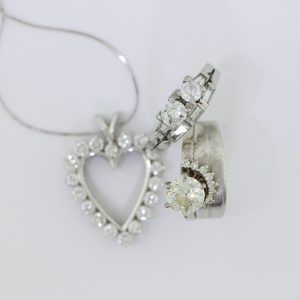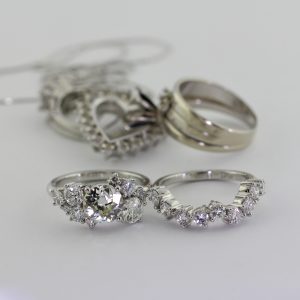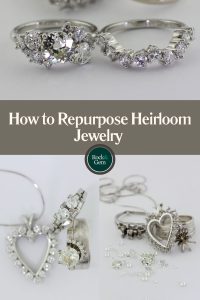
Repurposing heirloom jewelry is an affordable way to create a new piece of jewelry while keeping the sentimental value of the original piece. Although this is not a new concept, more and more custom jewelers are interested in helping you repurpose your jewelry and are getting better at techniques and design to do it.
The concept of recreating jewelry goes back centuries with the recutting of gemstones. As significant gemstones passed hands through generations, monarchies and new republics, the style of jewelry was also changing. The ever-increasing knowledge and improvement in gemstone performance and polishing techniques created the desire to recut valuable diamonds and precious colored gemstones. Although the jewels lost carat weight, the new design delivered a more wondrous jewel with a more modern look. Of course, a newly faceted gemstone would not look good or fit in its old tiara, scepter, necklace or crown, so a new piece of jewelry was created to show off the updated gemstone. Reusing gemstones and the precious metal that they are set in has been in practice for a long time.



WHY REPURPOSE HEIRLOOM JEWELRY?
These are the three most common of multiple reasons for taking apart a piece of heirloom jewelry and refashioning it.
1. Sentimental Value
The customer’s heirloom piece is significant to them because it belonged to an important person in their life. The final piece becomes a cherished memento that helps to preserve this possession in some capacity and serves as a reminder of that special person.
 We frequently see this with stones. Stones are often the heart of a piece, so it makes sense why people have an emotional attachment to the stones they have spent their entire lives looking at. The hands that wore them and the stories behind them increase their personal value. It is no surprise that the most common stones to repurpose are diamonds. Even the smallest hold meaning to family and friends.
We frequently see this with stones. Stones are often the heart of a piece, so it makes sense why people have an emotional attachment to the stones they have spent their entire lives looking at. The hands that wore them and the stories behind them increase their personal value. It is no surprise that the most common stones to repurpose are diamonds. Even the smallest hold meaning to family and friends.
In certain situations, it may be beneficial or preferred to have these stones recut to improve performance, to use a damaged stone that cannot be repaired, or to achieve a more desirable shape.
Metal can also be reused for sentimental reasons, although it is rarer. With most rebuilds or restorations, new metal is used. Typically, when incorporating antique gold, the primary purpose is to save on cost.
2. Cost Reduction
The customer’s jewelry is valuable to them because the materials hold a monetary value. Normally, the stones and metal would be separated and evaluated both for value as well as usability.
The two most common types of jewelry used in these situations are broken, mismatched and light-weight jewelry. Think of your grandmother’s pile of broken chains, single earrings and thin pendants. The second type is jewelry from the 70s and 80s.
A lot of the jewelry from this period follows the rest of the fashion at the time. Typically, these pieces are large and thick, yielding a lot of metal. Many nugget rings and twisted or nest-like pieces are repurposed. The more weight there is, the more scrap credit you can expect.
It is important to point out that using old gold in the creation of new jewelry is tricky. When using a customer’s old gold, it must be clean, solid and free of solder. Additionally, new gold material often needs to be added to make the old gold suitable for use in the new piece.
As a result, in some builds, it will cost more to use the customer’s heirloom metal than if the metal was newly purchased. This is why the most common use of heirloom metal is in the form of a bill credit. A scrap credit will immediately reduce the price for the customer.
In some cases, people will buy a piece of heirloom jewelry expressly to have the stones recut and the metal melted to re-fabricate a new piece to save money or incorporate rare gemstones into modern jewelry.
3. Blended
These customers value their old or heirloom jewelry because they belonged to someone important in their life and because the materials have value. Often, the design of the piece also carries meaning. These custom projects can be emotionally charged as customers want to honor the person, benefit from the value of materials and preserve the design. I often think of my job as an “object therapist” as I create meaningful designs intended to connect the customer with a loved one and help enliven them during their healing process after a loss.
These jobs tend to be the most difficult, as often everything involved with the build and material matters to the customer. They hold so much emotional value for our clients that the work to please the customer can be grueling and draining. However, when diligently executed, the crafted pieces become new family heirlooms, cherished and able to be passed down for generations to come. These pieces are some of our favorites to work on and can be the most rewarding, artistic and technical builds of the year.
Whatever the reason for repurposing heirloom jewelry, the actual process is very similar and can yield dazzling results that meet the needs of the client.
A REAL-LIFE EXAMPLE
In the build pictured in this article, our customer had attachments to the stones from the matriarchs of her family. This build involved the following old pieces, a 14k white gold and diamond heart necklace, a two-stone diamond engagement ring and three-baguette wedding band and a 14-karat and diamond engagement ring. She viewed the heirloom metal more as a cost reducer as she desired the final set to be created in platinum. As a result, the gold was weighed and valued and came directly off the top of the price.
After pulling and cleaning all the stones, we noticed that the second and third largest stones were badly chipped on the girdles. This was a shame as they were both old-world cut diamonds with high crowns, small tables and mid-large culets. These two stones were in the same ring, originally belonging to her grandmother, and had also been worn by other family members throughout the years. It had seen some wear!
We presented our findings and informed our customer that we could recut and polish her two diamonds to fix the chips while keeping the old-world charm of these stones. She agreed that spending the time and the money to have these stones recut was the way to go. Although these diamonds were on the smaller end, they were going in a new, modern design and we believed it made the most sense to have them recut.
KEEPING THE HEIRLOOMS
Our goal for this build was to utilize as many of the heirloom stones as possible. We started with the engagement ring layout. After playing with many variations, we landed on a cluster that our customer loved. A “sea of diamonds” is the feeling we were after. We used CAD software to engineer amounting set to our standards, while still being mindful of our customer’s vision.
Following the CAD, the setting seemed like a simple task until it was necessary to start placing 11 stones of different sizes and cuts, with all different setting needs, into position. It’s a dance between what looks good from the top view and how the final piece performs on the finger, or “wearability.” This is how the ring builds up from the shank, through minor stones, up to the major, or center stone, and back down again. In most cases, rings are symmetrical. Because of the differences and variabilities in the stones, we didn’t have that option. Again, our goal was to use as many heirloom stones as possible. This made the “wearability” or “ride” of the ring trickier than normal.
Once we had finalized the engagement ring design, we played with the remaining stones to create a layout for the companion wedding band. Our goal here was the same, to utilize as many stones as possible while filling the gaps of the engagement ring as efficiently as we could. The resulting engagement ring and wedding band set exceeded our customer’s expectations in both overall design and the volume of sentimentality we were able to retain.
REWARDING REBUILDS
If correctly done, the path of heirloom rebuilds can be rewarding and lucrative. We have found that people would rather accurately honor a loved one’s memory than cut corners to save on cost. The key to the success of this method relies on transparency, informing the customer of the real costs associated with their overall desired outcome, and allowing a reasonable amount of time for the build. These often take months from start to finish.
It is important that in these situations, the artist realizes that they are putting a price on the desires of another person. It is not the artist’s responsibility to craft it for the cheapest price. If the project takes extra steps and time, be sure to communicate this to the customer as ultimately, they are coming to us, asking “What will it cost to make this thing in my head?” If the artist’s price is too low, it is solely their error. People understand wants and are prepared to spend time and money on people they love. So put your best foot forward, swing for the fences, and knock the final piece out of the park!
This article about repurposing heirloom jewelry previously appeared in Rock & Gem magazine. Click here to subscribe. Story by Mark Farrell.













